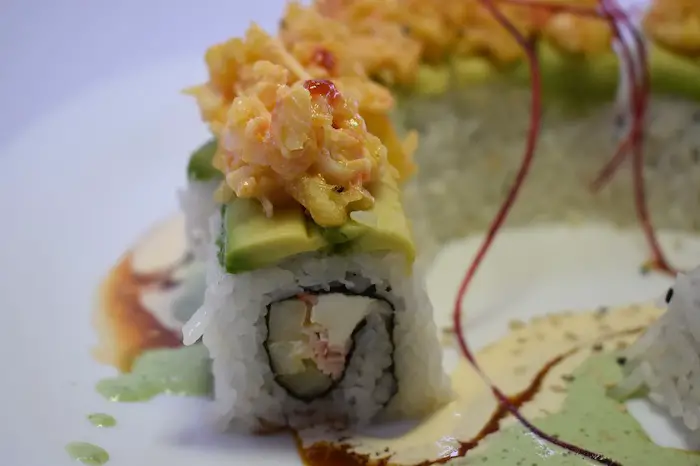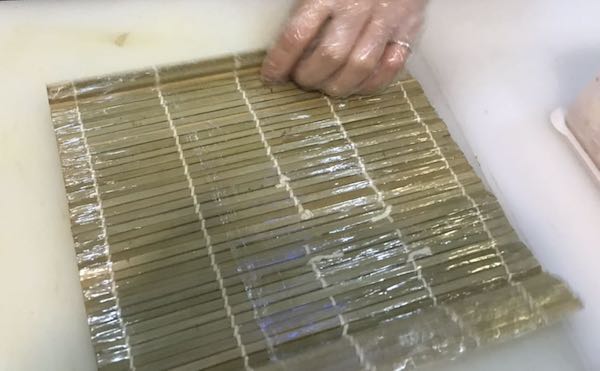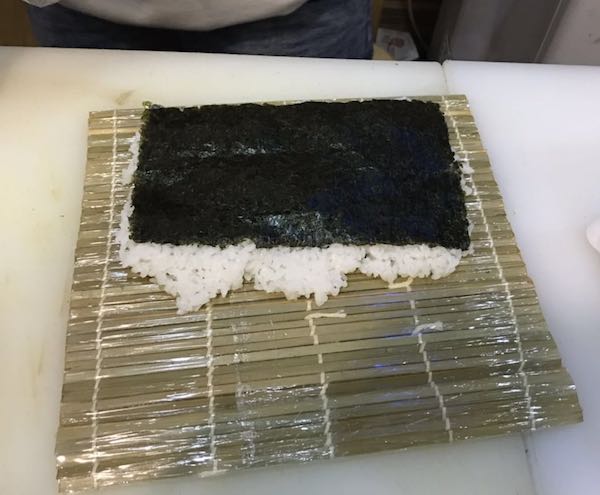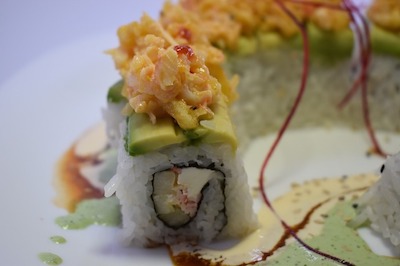We are reader supported. When you purchase through links on our site, we may earn an affiliate commission. Also, as an Amazon affiliate, we earn from qualifying purchases.

Uramaki is a Japanese term that literally means inside-out. This is a westernized style of sushi roll with rice on the outside and nori inside. Although people mostly think of makizushi when they hear ‘sushi’, the inside-out style has found its place on the menu of most sushi restaurants around the world.
Some chefs may also add different toppings to further adorn the uramaki and enhance its taste. Despite being a much-preferred type of sushi in the western countries, this non-traditional version is not very popular in Japan. The Japanese like to eat maki sushi with their hands and sushi rice is very sticky to touch.
To make this style of sushi, you will need to cover the bamboo mat with a plastic sheet to prevent the rice from sticking to it. Although it looks difficult to make at first glance, it gets easier as you practice. You will need a makisu or bamboo mat, and a few ingredients like rice, nori, vinegar, raw fish, and vegetables.
Have you ever wondered how uramaki came into existence? Who first thought about flipping the Nori sheet to have rice on the outer side? Why was this necessary? Let’s take a quick look into the history of uramaki to find out the answers.
Contents
Origin Of Uramaki (Inside-Out Rolls)
There’s a very interesting tale behind the origin of uramaki, and every person who loves inside-out rolls should know this. It is believed that the concept of uramaki sushi first emerged in Little Tokyo in the late 1960s. It was the need of the time, created by a Los Angeles-based Japanese chef named Machita Ichiro.
Ichiro owned a sushi restaurant called Tokyo Kaikan in Little Tokyo and he presumably had problems getting fresh fat belly tuna or toro to make sushi for his Japanese customers. As a result, he started to use avocado as a substitute because the fruit has a similar texture and melts in the mouth like toro.
When the number of foreign customers in his restaurant started rising, he realized that many westerners did not appreciate the appearance of nori. They would peel off the outer green cover and eat the inside part of sushi roll. This led him to innovate an inside-out sushi-style and hide the seaweed under rice.
This new style of sushi roll became an instant hit with the American customers, with more people demanding this roll. Soon the other restaurants also borrowed the concept and started making inside-out rolls to woo the non-Japanese population. Thus, the California Roll was born!
Even today, Uramaki continues to be an important style of sushi you can find in US restaurants. Some traditionalists do not approve of the inside-out roll because they think it destroys the essence of sushi and uramaki tends to fall apart easily when dipping in soy sauce. Despite the criticisms, Uramaki has found a respectable position in sushi culture with lots of patrons.
Easy Method To Make Uramaki At Home
If you love uramaki but eating out at sushi restaurants often burn a big hole in the pocket, here’s an easy method to make inside-out style rolls at home. You can get the ingredients needed for making this delicacy at a grocery store near you or buy them at Amazon.
What you will need
- 2 cups seasoned sushi rice (see how to make it)
- Half nori sheets
- 60 grams of canned tuna, drained
- 1½ tablespoon mayonnaise
- 2 pickled beetroot, cut into thin strips
- Half avocado, cut into thin slices
- Toasted sesame seeds
Instructions
Start by cooking sushi rice at least 30 minutes in advance because the rice needs to be seasoned and get to room temperature before you start rolling.
While the rice cools, prepare the fillings. Use a sharp Japanese knife like this to cut the cucumber into thin strips and avocado into fine slices.

Cover the bamboo mat with a cling film and tape it on the other side. Some people prefer to put the entire mat into a large size plastic bag and it fits perfectly.
Now, keep the nori sheet rough side facing up on the covered bamboo mat. Moisten your hands, take a medium ball of seasoned rice and spread it evenly over the nori sheet.
Leave about one-inch gap on the top end, away from you. Sprinkle some toasted sesame seeds over the rice for a crunchy texture.

Rest one hand on the plastic cover, lift the nori sheet with other hand and flip it over. Now, arrange the fillings side-by-side on a horizontal line on the bare nori sheet, towards the edge that is closer to you.
Put your thumbs under the bamboo mat and use other fingers to roll the sushi. Apply gentle pressure as you roll to get a compact shape. Hug the roll with the bamboo mat one more time to ensure that the rice doesn’t fall apart.
Now, take a sharp knife, moisten the blade and cut the roll into equal pieces with the plastic on. Remove the plastic and serve with soy sauce, wasabi, and pickled ginger.
If you would like to make the uramaki roll more filling and visually pleasing, you may add some toppings over the sushi rice. Ideas for toppings include avocado slices, raw salmon slices, tobiko or masago.
Vegan California Rolls (Uramaki Sushi)
If you are a vegan eater, here is the vegan version of California roll you can enjoy at home. I recommend you to make your own vegan food at home to avoid the risk of cross-contamination at restaurants.
What you will need:
- 2 cups of seasoned rice
- 4-5 pieces of Veggie Tofu, sliced
- Nori sheets
- Half avocado, sliced
- Half cucumber, seeds removed and sliced into matchsticks
- 2 tablespoons minced scallion (only green part)
Instructions
Cook sushi rice as per the instructions mentioned in my article, season it with vinegar, sugar, salt, and keep aside. Prepare the fillings while the sushi rice cools.
Put a bamboo mat covered with plastic cling film on the kitchen table and keep a nori sheet on it, textured side facing upwards.
Take a handful of sushi rice and spread it evenly on the nori sheet. Now, turn the seaweed upside down to have the rice side facing downwards.
On the nori side, add the veggie tofu strips towards the middle, place avocado slices and cucumber strips next to it.
Keep the thumb under the bamboo mat and start rolling with the help of other fingers. When you reach the other end, seal the edges with a few drops of water.
Cover the roll with bamboo mat one more time and hug tightly to give it a compact form. Now, roll the uramaki sushi in a plate of finely minced scallions to coat it with the green part. Serve with soy sauce, wasabi, and pickled ginger.
7 Interesting Facts About Uramaki (Inside-Out Rolls)
- Uramaki was invented as a ‘necessity’ to hide nori sheet inside sushi rice to woo the western customers who were not familiar with seaweed.
- Each uramaki roll contains about 255 calories and 7 grams of fat, but there is also 9 grams of protein, which makes it healthy depending on your choice of fillings/ toppings
- As the nori is hidden inside, it will not split like maki rolls even if the uramaki is kept outside for a long time.
- Chefs have the liberty to add fillings as well as decorative toppings over the sushi roll to make it more eye-catching.
- Each uramaki roll has about 80 milligrams of sodium, which is one-third of the recommended intake for adults but more than those who are on a low-sodium diet.
- The sushi rice layer on the outer side of uramaki rolls is often covered in toasted sesame seeds or masago to keep the form intact.
- Specialty rolls are typically created uramaki-style and they comprise of more than the standard six pieces. They may be cut into nine or more pieces.
Popular Types Of Uramaki
The idea of making inside-out rolls has been used in creating a plethora of uramaki rolls. They are called by different names, sometimes based on city-names or the type of insect or animal they resemble, but the basic style remains the same.
If you visit a sushi restaurant, you can see bizarre names such as Godzilla rolls, dragon rolls, caterpillar rolls, Boston rolls, and so on. They are all uramaki sushi with rice on the outside and nori hidden inside. However, the fillings and toppings used in each of them may vary widely.
The ease of making them at home may also differ. I have created a list of uramaki rolls you can make at home, starting from the easiest one to the more difficult and time-consuming style.
California Rolls

This is the flag bearer of uramaki rolls and the one that started the trend of making inside-out sushi in order to cover the seaweed inside a layer of rice. It, later on, became the base for numerous types of western rolls and specialty rolls.
The typical California roll comprises of the basics like avocado, cucumber, and cooked crab or imitation crab. As this is a fully cooked roll, it is a perfect dish to introduce beginners to sushi. I have created an article that explains how to make California rolls at home easy.
Philadelphia Roll
The reason why I love Philadelphia roll so much is that it perfectly suits the rebel-nature of uramaki sushi roll. This style was popularized by a lady chef named Madame Saito. In Japan, it was against the customs for women to become sushi chefs so Saito worked as an apprentice under the masters after the restaurants closed down.
In 1981, she moved to Philadelphia and started her own sushi restaurant. She also gave classes to help fans learn how to make sushi. ‘Philly roll’ is believed to be her brainchild. It comprises of things that are popular in Philadelphia – smoked salmon, avocado, cucumber, and cream cheese. I have created an article that explains – What’s In A Philadelphia Roll And How To Make It.
Alaskan Roll
The Alaskan roll is very much similar to the California sushi roll as it contains imitation crab (kani) and avocado slices inside. The only difference is that in an Alaskan roll, you will also find raw salmon inside or outside the roll.
Blossom Roll
This sushi roll is named ‘blossom’ for a reason. It almost looks like a flower petal with reddish/pink outer layer due to the presence of raw salmon or tuna. The fillings may differ but they usually contain shredded crab meat and avocado. The roll is then cut into bite-size pieces and arranged beautifully to look like a flower.
Boston Roll
This is another interesting variation of California roll but comprises of a thinner layer of sushi rice, poached shrimps, cucumber, and avocado. The outer layer is mostly covered with tobiko or red flying fish roe to give a crunchy texture on the outside.
Dragon Rolls
The name itself is enough to pique interest but the ingredients are also equally good. It contains delicious shrimp tempura and cucumber strips inside. The outside of the roll is covered with thin avocado slices and roasted eel to resemble the scales of a dragon. It is further adorned with sriracha sauce, eel sauce, and fish eggs. I have created an article that shows how to make a dragon roll with cooked eel and a vegan recipe too.
Caterpillar Roll
Regardless of whether you are an insect lover or not, you are sure to love the delectable taste of Caterpillar Roll that is filled with roasted eel inside and topped with tasty avocado slices. This is another fully cooked sushi roll that is perfect for anyone who wants to try sushi but is not comfortable with eating raw fish.
Rainbow Roll

This is an ultimate uramaki roll with so many different varieties of fish that you will be spoilt or choice. The different colors and textures of fish used as topping give this sushi a beautiful appearance that resembles a rainbow.
The fillings include imitation crab sticks and cucumber, while the toppings may be made of salmon, tuna, red snapper, yellowtail, and whitefish. I have created an article that talks about the best rainbow sushi rolls, both made with fish and vegetables.
Crazy Boy Roll
What do the big boys love? Seafood, crabsticks, cream cheese! This is a high-calorie uramaki sushi loaded with ingredients that guys love and batter-fried until it becomes crisp on the outside. If your boyfriend or husband is health-conscious, skip the frying part and add some toppings like fish eggs, avocado, and salmon.
Lion King Roll
Kids love this one as it brings the Lion King on the table. This is a gorgeous uramaki California roll with avocado and crab fillings inside. On the outside, it is layered with salmon slices and tobiko basted with spicy mayo and unagi sauce. The roll may be oven-baked and garnished with scallions.
Michigan Roll
Named after one of the most popular cities in the United States, this uramaki roll follows the tradition of naming rolls after cities in which they are created. It is typically filled with avocado slices and cream cheese crab mixture. The roll is topped with smoked or raw salmon.
Red Head Sushi Roll
I don’t know why the creator named this sushi red head sushi roll, probably due to the toppings made of crunchy flakes and spicy tuna which is red in color. The fillings comprise of shrimp tempura and cucumber that adds a crunchy taste to the delicacy.
Surf And Turf Roll
Beef lovers are sure to swoon over this one! The roll comprises of amazing flavors of seafood and meat. You have shrimp, cucumber, and asparagus inside, while the toppings are made of seared beef, spicy scallop, garlic aioli, and ao nori. The dish is further glazed with chili sauce, kabayaki sauce, and ponzu sauce.
Snow Roll
This is one of my favorites as it contains blue crab inside, along with asparagus, and cucumber. The toppings are made of imitation crab, tobiko, and hamachi that gives a white snow-like appearance to the sushi roll.
Specialty Rolls Based On Uramaki Style
In American restaurants, you will find specialty rolls that are made with delicious fillings and toppings to present a riot of amazing flavors. They are usually invented by passionate sushi chefs and they could be the reason behind the popularity of a specific restaurant.
All these rolls are made on uramaki foundation because it presents the sushi chef with the liberty to use ingredients both inside and outside sushi. They are mostly gigantic in size, making it difficult to consume in one bite. Here are some of the interesting ideas to make your own specialty sushi rolls at home.
Tataki Roll: This delicious uramaki comprises of avocado slices, cucumber strips and asparagus rolled inside, and topped with seared filet mignon and micro greens. It is served with creamy wasabi sauce and mustard vinaigrette.
Crunchy Calamari Roll: This is a crunchy inside-out sushi roll filled with calamari tempura, cream cheese, and crab mix inside. It is topped with tempura bits on the outside and served with sweet eel sauce.
Mango Shrimp Roll: If you are a fan of this luscious summer fruit, you will love the uramaki paired up with seafood. It comprises of avocado, shrimp tempura, and cucumber rolled inside and topped up with fresh mango slices and seared salmon. The light drizzle of eel sauce and tempura bits garnishing makes it Instagram-ready!
Spicy Salmon Roll: Just as the name suggests, this inside-out roll comprises of salmon mixed with spicy mayo mixture, rolled in sushi rice and seaweed.
Scallop Dynamite Roll: This scrumptious roll comprises of lightly tempura battered crab, and cream cheese strips inside. It is topped with baked mushrooms and scallop dynamite. Garnished with sesame seeds, green tempura bits, and sweet eel sauce.
Yellowtail Roll: This spicy uramaki roll comprises of yellowtail, avocado, cucumber, cilantro, and jalapeno inside, and topped with crispy garlic, and green onion. It is drizzled with chili ponzu sauce to enhance the flavor.
Mango Lobster Roll: Try this mouthwatering combination at home with avocado, cucumber, and lobster crab mix inside. Toppings include tobiko, mango slices, and kiwi wasabi sauces.
Crunchy Shrimp Tempura Roll: You are probably already familiar with the shrimp tempura roll. Add more ‘crunchiness’ by topping it up with tempura bits and serve with delicious eel sauce.
Spicy Lobster Roll: This spicy seafood roll is what you need to perk up your mood on any given day. It contains spicy lobster crab mixed with avocado, lettuce, and cucumber inside. On the outside, you may use toppings like sesame seeds and masago.
Monkey Roll: This colorful uramaki sushi comprises of cream cheese, mango, and smoked salmon inside, topped with red tempura bits, sautéed cashews, and avocado. Drizzle the roll with sweet eel and mango sauces.
“Ra” Ckin’ Roll: This specialty uramaki contains cream cheese and crab rolled and slightly tempura battered. It is then topped with “Ra” Ckin’ shrimp and guacamole. Garnished with red tempura bits, ginger teriyaki sauce, and togarashi.
Chili Shrimp Roll: This inside-out roll comprises of cream cheese and crab roll slightly tempura battered and topped with crispy shrimp, jalapeño, and cilantro. It is served with Sriracha and spicy mayo.
Shrimp Calamari Tempura Roll: This uramaki style roll comprises of calamari and shrimp tempura with avocado, cucumber, and cream cheese. It is topped with tempura bits and served with soy sauce and sweet eel sauce.
Vegetable Tempura Roll: Enjoy lightly fried sweet potato tempura and asparagus inside the roll and topped with green tempura bits. Served with eel sauce.
Viva Las Vegas Roll: This uramaki comprises of cream cheese and crab, topped with sliced lotus root, green tempura bits, and spicy tuna slices. Serve with sweet eel sauce.
Related Questions
Can I find Uramaki in Japan
The Japanese respect their traditions and prefer sticking to the roots so you may not find specialty rolls at the neighborhood sushi shop, but the fine dining restaurants may serve uramaki sushi for non-Japanese customers.
Are uramaki rolls cooked?
Some of them like California rolls and Philadelphia rolls are cooked options, perfect for beginners who don’t like the taste of raw fish. The rest may have raw fish inside or use as toppings over the outer rice layer.
Are uramaki sushi hot or cold?
This depends on the type of fillings or toppings used. Sushi rice is ideally at room temperature and the fillings (raw fish) may be cold but the fried or cooked options may be hot. If a roll has tempura inside it, consume immediately while it’s still warm because it gets soggy when cold.
Why do you need a bamboo mat to make uramaki rolls?
In this style of sushi making, the rice part is flipped to face downwards. Hence, it’s important to cover the bamboo mat with a cling film to prevent the rice from sticking to it.
See Also:
How To Prevent Sushi From Getting Soggy?
15 All You Can Eat Sushi in San Diego
What Kind Of Salmon Is Best For Sushi?
Sushi Eel Sauce (Unagi) Recipes
What Is Sushi Without Rice Called?

